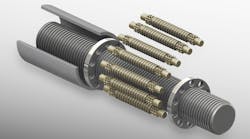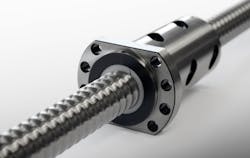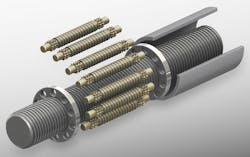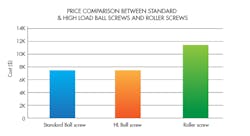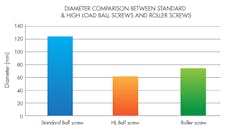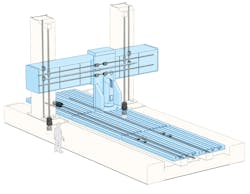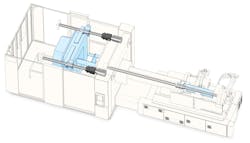High-Load Ball Screws: Motion Control with Higher Load Densities
Here’s a little engineering quiz for you: If an app needs to move a 500 kN axial load along a 1,500 mm stroke, is it best to use a roller screw or ball screw?
If you instinctively said roller screw, you may not be familiar with high-capacity ball screws as an economical and simplified alternative. Roller screws have been promoted as the only choice for handling large loads when size is a constraint. But today, advances in ball screws have led to improved versions that can handle high-load applications. This is important because high-load ball screws typically cost 50% less than comparable roller screws.
High-load ball screws, such as this one from Thomson, can be used in machines for injection molding machines, metal pressing and forming, straightening, and tube-bending machines, as test rigs.
What’s the Difference?
A ball screw consists of a threaded metal shaft with a nut that rides along its length as a motor turns the shaft. The nut supports a table, arm, or other load that needs to move in a straight line. Re-circulating ball bearings within the nut follow the shaft’s threads and distribute the load from the table or arm to the bearings and then to the screw. The bearings also let the nut move smoothly along the screw with a low coefficient of friction, allowing it to operate at greater than 90% efficiency. Most of the motor’s force goes into motion, not overcoming friction.
The load capacity of the ball screw is a function of the diameter of the ball bearings, the number of ball bearings, and the total surface contact area between the bearings and the thread. The combination of these parameters defines the assembly’s load capacity and, therefore, the resultant life of the components.
Ball screws consist of a threaded metal shaft with a nut that travels its length as a motor turns the shaft (top). The nut connects to a table, an arm or other load. Inside the nut (bottom), ball bearings ride in the threads to reduce friction, and three different ball recirculation devices are available from Thomson.
For higher loads, engineers specify roller screws. In a roller screw, the load-bearing mechanism is a set of recirculating rollers instead of balls. The rollers have more surface contact area than balls, so the load carrying capacity increases, and so can the service life.
But these benefits come at a premium. Compared to relatively simple, time-tested ball screws, roller screws require extensive upfront precision machining and more complex assembly. This contributes to the roller screws’ overall higher costs and larger installed size.
Roller screws consist of a set of recirculating rollers. Roller bearings with grooved rolling elements have more total surface contact area than balls. As a result, service life and load-carrying capacity increases.
High-Load Ball Screw
A high-load ball screw developed by engineers at Thomson Industries uses a specially designed thread form that increases load-bearing capacity by a factor of four to eight compared to traditional ball screws. This lets designers use ball screws in almost any application that previously required roller screws. Or the designer can extend the life of the assembly by using the high-load ball screw in a low-load application. That’s because the assembly’s life is a function of the load capacity (see “L10 Life Expectancy Calculation for Ball Screws,” below).
This table shows the advantage of a high-load ball screw in an application that requires at least 470 kN of load capacity. A standard ball screw can handle the job, but it would have twice the diameter and cost 63% more. A roller screw can also do it, but only with a nut close to 50% larger, and the assembly would cost 150% the price of the high-load ball screw.
Comparing Ball Screws
High-load ball screws are typically available with screws up to 15-m long, with single or double nuts, and in standard sizes up to 160 mm in diameter. Their dynamic load capacity tops out at 1,440 kN.
Applications that stand to benefit the most from these new ball screws include large fabrication and injection molding machines, and industrial security doors and gates used in nuclear power plants. Large fabrication machines rely on ball screws to drive horizontal and vertical axes and provide long and reliable performance with minimum maintenance. Mills, water jets, plasma cutters, automatic welders, and other large equipment used in industrial fabrication must often move heavy loads accurately and safely across ball-screw-driven horizontal and vertical axes.
Consider a machine running a 100 kN load 24/7, for example. Based on the standard life calculation, a ball-nut drive in the application may last three to four months, according to fatigue failure analysis and statistical life expectancy. Using a high-load ball screw instead doubles the load capacity and yields eight times the life, getting more value out of the drive while reducing maintenance costs. It also lets managers of each production unit adjust the machine for higher load capacity, longer assembly life, or some balance of both.
Injection molding, pressing, and metal fabrication machines require ball screws to handle high loads in short, precise strokes. The machines must control accuracy and manage product tolerances. An injection molding application, for example, might require 400 kN of force over 500 mm, for which a designer might traditionally specify a more expensive roller screw. But that high force is only required for maybe the last 10 mm of travel, when the mold is being compressed. The user, however, is still paying a premium to move a high load across the full stroke. Substituting a high-load ball screw for a roller screw means there is still power to complete the final 10 mm, plus the additional load-bearing potential gets converted into an extended operational life.
Specifying high-load ball screws in applications previously relegated to roller screws can save money, extend product life, or both. Any new application will require careful analysis of load capacity, product life, and cost, which may uncover some applications well suited to roller screws. But given new ball screw technology advances that increase their load-bearing capacity, it is now wise to consider high-load ball screws in any application for which you might’ve previously considered a roller screw.
Ball screw-driven horizontal and vertical axes are used in large fabrication machines which move heavy loads accurately and safely. This ensures a long and reliable life with minimum maintenance.
L10 Life Expectancy Calculation for Ball Screws
Bearings are often specified to give an "L10" (or in some countries, “B10”) life. This is how long it should take 10% of the ball screws in an application to fail due to classic fatigue failure or, alternatively, the time at which 90% should still be operating. The L10 life of the ball screw is theoretical and may not be its actual service life. It can be calculated according to the following formula:
L10 = (Cam/Load)3
Where L10 = Life expectancy (in millions of revolutions)
Cam = Dynamic capacity of the ball screw (kN)
Load(kN)
In injection molding and metal fabrication machines, ball screws handle high loads in short strokes. They also provide the needed accuracy and tolerances.
Denise Goldman is the product line manager for ball screws at Thomson Industries Inc. If you have any questions about balls screws, write to [email protected] visit www.thomsonlinear.com.
